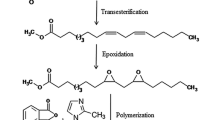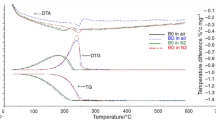Abstract
The radical abstraction reaction of (bis)-allylic hydrogen in biodiesel fatty acid chains is the first step of autoxidation, being the rate-determining one. Some intrinsic features of the intermediary radicals can determine the oxidative stability (OS) under thermodynamic control. In the present study, some common fatty acid methyl esters present in biodiesel (stearate, oleate, ricinoleate, and linoleate) were oxidized in non-isothermal conditions, using differential scanning calorimetry, and the results were compared with quantum chemical calculations at the density functional theory level. The OS order (saturated > monounsaturated > polyunsaturated) was observed in both approaches (experimental and theoretical). A slight deviation observed between oleate and ricinoleate OS’s was explained based on their allylic radicals resonance and the influence of vicinal hydroxyl group. A linear relationship was found between oxidation temperature by pressurized differential scanning calorimetry and the calculated bond dissociation energy (C–H) for the first step of autoxidation.







Similar content being viewed by others
References
Singh SP, Singh D. Biodiesel production through the use of different sources and characterization of oils and their esters as the substitute of diesel: a review. Renew Sust Energ. 2010;14:200–16.
Knothe G. “Designer” biodiesel: optimizing fatty ester composition to improve fuel properties. Energy Fuel. 2008;22:1358–64.
Tallman KA, Roschek B Jr, Porter NA. Factors influencing the autoxidation of fatty acids: effect of olefin geometry of the nonconjugated diene. J Am Chem Soc. 2004;126:9240–7.
Derek AP, Jeremy HM, Porter NA. Theoretical calculations of carbon-oxygen bond dissociation enthalpies of peroxyl radicals formed in the autoxidation of lipids. J Am Chem Soc. 2003;125:5801–10.
Dantas MB, Albuquerque AR, Soledade LEB, Queiroz N, Maia AS, Santos IMG, et al. Biodiesel from soybean oil, castor oil and their blends. J Therm Anal Calorim. 2011;106(2):607–11.
Moser BR. Comparative oxidative stability of fatty acid alkyl esters by accelerated methods. J Am Oil Chem Soc. 2009;86:699–706.
Albuquerque AR, Maul J, Santos JP, Santos IMG, Souza AG. Estimation of the oxidation temperature of biodiesels from a limited number of chemical parameters. Fuel. 2012;102:585–91.
Santos NA, Damasceno SSS, Araújo PHM, Marques VC, Rosenhaim R, Fernandes VJ, et al. Caffeic acid: an efficient antioxidant for soybean biodiesel contaminated with metals. Energy Fuel. 2011;25:4190–4.
Vasconcelos AFF, Dantas MB, Filho MGR, Rosenhaim R, Cavalcanti EHS, Antoniosi Filho NR, et al. Influence of drying processes on oxidative stability of ethyl corn biodiesel by differential scanning calorimetry. J Therm Anal Cal. 2009;97:657–60.
Bateman L. Olefin oxidation. Quart Revs. 1954;8:147–67.
Carey FA, Sundberg RJ. Advanced organic chemistry—part a: structure and mechanism. 5th ed. New York: Springer; 2007.
Musialik M, Litwinienko G. DSC study of linolenic acid autoxidation inhibited by BHT, dehydrozingerone and olivetol. J Therm Anal Cal. 2007;88(3):781–5.
Kowalski B. Thermal-oxidative decomposition of edible oils and fats. DSC studies. Thermochim Acta. 1991;184(1):49–57.
Litwinienko G. Autoxidation of unsaturated fatty acids and their esters. J Therm Anal Cal. 2001;65:639–46.
Roman O, Maillard MN, Plessis C, Riquet AM. Electron spin resonance spectroscopy: a promising method for studying lipid oxidation in foods. Lipid Technol. 2010;22:87–90.
Velasco J, Andersen ML, Skibsted LH. Evaluation of oxidative stability of vegetable oils by monitoring the tendency to radical formation. A comparison of electron spin resonance spectroscopy with the Rancimat method and differential scanning calorimetry. Food Chem. 2004;85:623–32.
Santos VML, Silva JAB, Stragevitch L, Longo RL. Thermochemistry of biodiesel oxidation reactions: a DFT study. Fuel. 2011;90:811–7.
HyperChem(TM) Professional 8.0. Gainesville, Fl 32601, USA.: Hypercube, Inc. 2011.
Dewar MJS, Zoebisch EG, Healy EF, Stewart JJP. AM1: a new general purpose quantum mechanical molecular model. J Am Chem Soc. 1985;107:3902–9.
Becke AD. Density-functional thermochemistry III. The role of exact exchange. J Chem Phys. 1993;98:5648–52.
Lee C, Yang W, Parr RG. Development of the Colle-Salvetti correlation-energy formula into a functional of the electron density. Phys Rev B. 1988;37:785–9.
Møller C, Plesset MS. Note on an approximation treatment for many-electron systems. Phys Rev. 1934;46(7):618–22.
Frisch MJ, Trucks GW, Schlegel HB, Scuseria GE, Robb MA, Cheeseman JR, et al. Gaussian 09, Revision A.02. Gaussian, Inc., Wallingford CT, 2009.
Lizhi HU, Toyoda K, Ihara I. Dielectric properties of edible oils and fatty acids as a function of frequency, temperature, moisture and composition. J Food Eng. 2008;88:151–8.
Ulkowski M, Musialik M, Litwinienko G. Use of differential scanning calorimetry to study lipid oxidation. 1. oxidative stability of lecithin and linolenic acid. J Agric Food Chem. 2005;53:9073–7.
Yu-Ran L. Comprehensive handbook of chemical bond energies. Boca Roton: CRC Press, Taylor & Francis Group; 2007.
Bascetta E, Gunstone FD, Walton JC, An electron spin resonance study of fatty acids and esters.part 1 hydrogen abstraction from oleic acid and acetylenic long chain esters. J Chem Soc Perkin Trans II. 1983;603–613.
Brash AR. Autoxidation of Methyl Linoleate: identification of the Bis-allylic 11-Hydroperoxide. Lipids. 2000;35(9):947–52.
Pratt DA, Tallman KA, Porter NA. Free radical oxidation of polyunsaturated lipids: new mechanistic insights and the development of peroxyl radical clocks. Acc Chem Res. 2011;44(6):458–67.
Acknowledgements
The authors would like to thank CAPES, CNPq, and FINEP for financial support. We also thank Professor Gerd Bruno Rocha for his valuable help on all calculations as well as discussions about theoretical results and Professor José Geraldo de Paiva Espíndola for evaluation of the final manuscript.
Author information
Authors and Affiliations
Corresponding author
Rights and permissions
About this article
Cite this article
dos Reis Albuquerque, A., Maul, J., Vasconcelos, A.F.F. et al. The first step of biodiesel autoxidation by differential scanning calorimetry and DFT calculations. J Therm Anal Calorim 117, 799–806 (2014). https://doi.org/10.1007/s10973-014-3835-y
Received:
Accepted:
Published:
Issue Date:
DOI: https://doi.org/10.1007/s10973-014-3835-y




